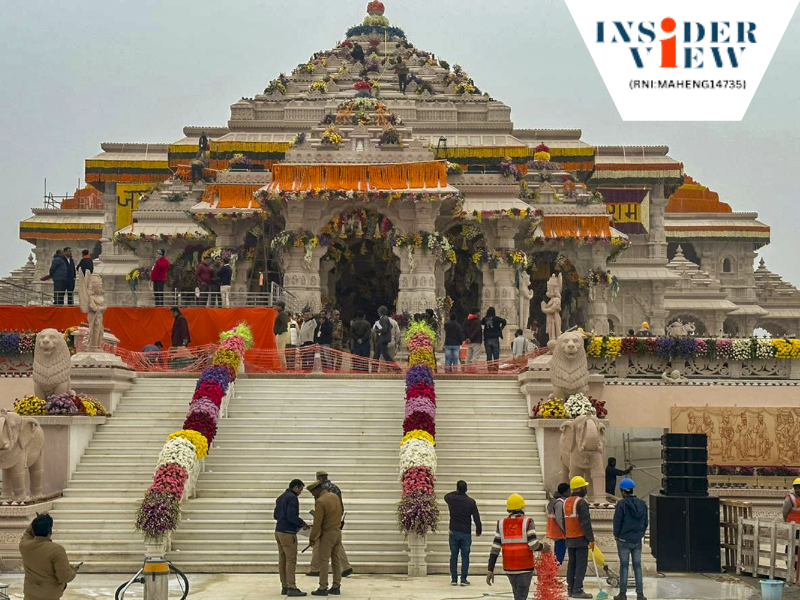Ayodhya, 21 February (HS): Sleeper buses that have transported people from faraway locations are lined up along the route to access the massive parking lots, 12 kilometers from Ayodhya’s Ram Temple. A month after the new temple’s dedication, the need for a ‘darshan’ persists.
Devotees from all around the country congregate in holding areas in their distinctive traditional attire before taking electric buses or e-rickshaws to the temple. These devotees, together with others from surrounding areas, congregate on Ram Path, which leads to the great temple. With no traffic, one can only observe devotees strolling towards the temple on the left side of the road and returning on the other. A month after the big consecration ceremony, festivities in Ayodhya are in full swing, with lakhs of pilgrims flocking to the holy city to see Lord Ram’s statue in the freshly erected temple. One can experience the bustle of religion at Ram temple, the center of Ayodhya, from more than 10 kilometers away, as busses transporting devotees from far distant regions line up along the highways. According to Ram Janmabhoomi Teerth Kshetra authorities, around 25 lakh devotees visited the temple within the first ten days after its dedication.
In February, we receive between one and two lakh devotees each day. According to Prakash Gupta, office in-charge of the temple trust, the number of devotees who have visited the temple so far is believed to be between 50 and 60 lakh.
Some devotees hail “Jai Sri Ram” as they go to the temple, while others recite Ramayan couplets. Most people go barefoot with their group. Small stores along the path, selling sweetmeats and other offerings for the shrine. Locals, particularly youngsters, stand along the road with little colorful tumblers. When the devotees give a nod, they dip three fingers in a yellow liquid and apply it on the pilgrims’ foreheads. They then dip an inch-long stencil with the word ‘Ram’ in Hindi in a red liquid before placing it in the center of the finger markings and charging for it.
Devotees approach towards the temple with Lord Ram’s name written on their foreheads. Looking down from above, the rampart looks to be a confluence of India, with people dressed in various traditional clothing that indicate whatever state or area they belong to.
On Tuesday, a group from Maharashtra walked behind a group from Rajasthan, with ladies dressed in sarees knotted in a peculiar Nauvaree manner and men wearing a white shirt over a white lungi and a white Gandhi cap. The desert state’s men wore enormous brightly colored turbans, while the ladies wore brightly colored sarees, in contrast to a group from Uttarakhand, where the males wore pahadi topis and the women strolled in long skirts.
After nearly a two-kilometre trek, the mob of believers forms a queue, only to be led by police officers stationed along the path leading to the temple. Most people stand with their hands folded while waiting in line to visit Lord Ram’s idol. While some chant “Ram Ram” with their eyes closed, others repeat the name of Lord Ram on a daily basis.
These shouts get louder as the queue enters the temple and fade when devotees approach the sanctum sanctorum and witness the majestic figure of Lord Ram. Devotees fold their hands, lift them over their heads, and kneel in reverence before the diol as they go forward.
“My years-long dream has come true.” Subhash Kumawat (59), a resident of Tonk area in Rajasthan, stated, “I never thought I would be able to see Lord Ram in a temple in my lifetime, but my wish has been granted.” The queue slows somewhat after crossing the sanctum sanctorum, as if they want to spend a few more seconds in such close proximity to their lord. It, however, detects when you leave the temple and is guided out by police officers.
According to residents, depending on the time of day, the line for darshan of the Ram deity might last anywhere from one hour to four hours.
I felt compelled to sit before Lord Ram and spend a few more minutes in the temple. But I got to see Lord Ram; what more can I ask for? asked Manshi Karmakar, a homemaker from Pune. The sentiments echo the thoughts of other devotees as they walk out of the temple and down Ram Path, returning home with Lord Ram in their hearts.



Leave a Reply